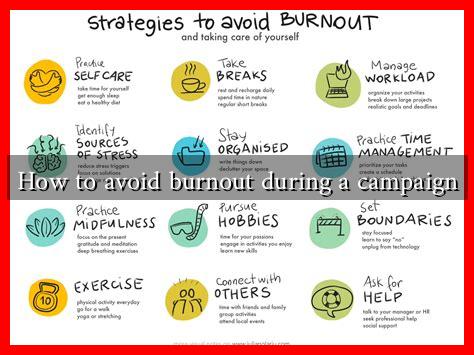-
Table of Contents
How to Avoid Burnout During a Campaign
Campaigns, whether political, marketing, or social, can be exhilarating yet exhausting. The pressure to perform, meet deadlines, and achieve goals can lead to burnout, a state of emotional, physical, and mental exhaustion. Understanding how to manage stress and maintain well-being during a campaign is crucial for success. This article explores effective strategies to avoid burnout and sustain productivity throughout the campaign lifecycle.
Understanding Burnout
Burnout is characterized by chronic stress that leads to feelings of exhaustion, cynicism, and reduced professional efficacy. According to a study by the World Health Organization, burnout is a significant occupational phenomenon that can affect anyone, especially those in high-pressure environments like campaigns. Recognizing the signs of burnout is the first step in prevention:
- Chronic fatigue and lack of energy
- Increased irritability and mood swings
- Reduced performance and productivity
- Feelings of detachment or cynicism
Strategies to Prevent Burnout
Implementing proactive strategies can help mitigate the risk of burnout during a campaign. Here are some effective approaches:
1. Set Realistic Goals
Setting achievable goals is essential for maintaining motivation and focus. Break down larger objectives into smaller, manageable tasks. This not only makes the workload feel less overwhelming but also allows for regular accomplishments that can boost morale.
2. Prioritize Self-Care
Self-care is vital for mental and physical health. Incorporate the following practices into your routine:
- Regular exercise: Physical activity can reduce stress and improve mood.
- Healthy eating: A balanced diet fuels the body and mind.
- Quality sleep: Aim for 7-9 hours of sleep per night to recharge.
- Meditation and mindfulness: These practices can enhance focus and reduce anxiety.
3. Foster a Supportive Environment
Creating a supportive team culture can significantly reduce stress levels. Encourage open communication and collaboration among team members. Regular check-ins can help identify issues before they escalate. For example, during the 2020 U.S. presidential campaign, many teams implemented daily stand-up meetings to discuss progress and challenges, fostering a sense of community and support.
4. Manage Time Effectively
Time management is crucial in a fast-paced campaign environment. Utilize tools and techniques such as:
- Time blocking: Allocate specific time slots for tasks to enhance focus.
- Prioritization matrices: Identify urgent vs. important tasks to streamline efforts.
- Delegation: Empower team members by assigning tasks based on their strengths.
5. Take Breaks
Regular breaks are essential for maintaining productivity and creativity. The Pomodoro Technique, which involves working for 25 minutes followed by a 5-minute break, can help maintain focus while preventing fatigue. Additionally, consider longer breaks for relaxation and rejuvenation, such as a weekend getaway or a day off.
Case Studies: Successful Campaigns and Burnout Prevention
Several successful campaigns have prioritized mental health and well-being, leading to better outcomes. For instance, the 2016 campaign of a prominent political figure emphasized work-life balance, allowing team members to take time off when needed. This approach not only reduced burnout but also resulted in a more motivated and engaged team.
Another example is the marketing campaign for a major tech company that implemented wellness programs, including yoga sessions and mental health days. The result was a 30% increase in team productivity and a significant reduction in turnover rates.
Conclusion
Avoiding burnout during a campaign is not just about managing stress; it’s about creating a sustainable work environment that fosters well-being and productivity. By setting realistic goals, prioritizing self-care, fostering a supportive culture, managing time effectively, and taking regular breaks, campaign teams can navigate the challenges of high-pressure environments successfully. Remember, a healthy team is a productive team, and investing in mental health is an investment in the campaign’s success.
For more insights on managing stress and preventing burnout, consider exploring resources from the American Psychological Association at apa.org/topics/stress.

